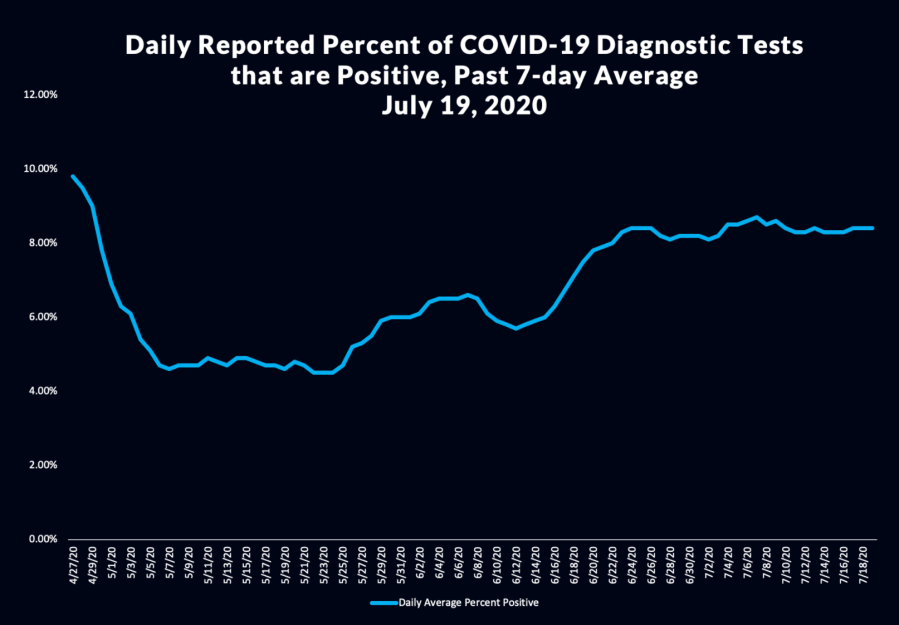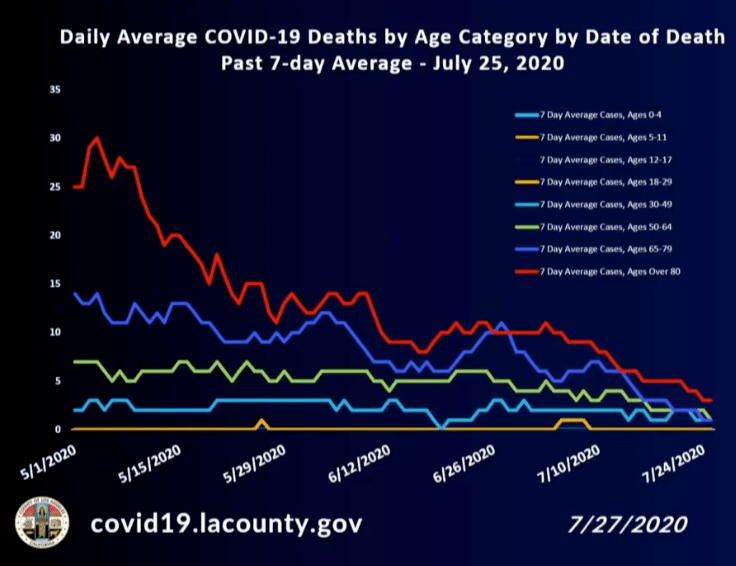Younger residents continue to drive up Los Angeles County’s new coronavirus case numbers while COVID-19 deaths are declining among those ages 65 and older, and in nursing homes countywide.
Health Director Barbara Ferrer said the county could avoid another shutdown if residents followed public health orders and officials stepped up containment.
“At this stage in the pandemic, we believe we have a lot of tools available, that if fully utilized, should allow us to slow the spread without going back to the more stringent safer-at-home orders that were in place earlier in the pandemic,” she said.
L.A. County recorded 2,039 new coronavirus infections and another 17 deaths Monday, bringing the countywide case total to 176,028, with 4,375 fatalities.

The county’s coronavirus positivity rate stood at 9% Monday — still high but notably lower than the 11.6% rate reported just three weeks ago.
Gov. Gavin Newsom told counties they can open key sectors, including schools, when their coronavirus positivity rate sinks below 8% and there are fewer than 100 cases per 100,000 residents. As of Monday, L.A. County reports 400 cases per 100,000, Ferrer said.
“We’re not where we need to be,” Ferrer said. “But with all of our collective efforts, we can begin to move again in the right direction and we’re up to this challenge — we’ve bent the curve before. Now we’re armed with a lot more information about this virus.”
While nursing homes were especially hit hard by the deadly virus in the early months of the pandemic, L.A. County started seeing more outbreaks in workplaces and among younger residents after restrictions were loosened and more people went to work.
By July, the virus was infecting more young people than ever before — with 76% of new cases reported among people under 50 years old and 54% of them younger than 30.
People between 30 and 49 years old have accounted for the largest proportion of cases since May, while case among people in all other age groups have stabilized or decreased slightly.
L.A. County continues to experience a decline in the seven-day average number of deaths among people who live in skilled nursing facilities, Ferrer said. Currently, an average of about six people at skilled nursing facilities die of COVID-19 each day, compared to 25 daily deaths in early May.
The countywide seven-day average of COVID-19 deaths has been declining in recent weeks, including for all race groups.
“It’s difficult to say whether this trend will continue in the coming weeks,” Ferrer said. “We do have a significant number of people over time, who are young and are in fact, unfortunately, passing away from COVID-19.”

The spike in infections led to a continued surge in hospitalizations, drawing alarm and in part prompting officials to issue grim warnings and roll back reopenings, explaining that it would take weeks to see whether the measures succeeded in containing the spread of the virus.
A total of 2,017 residents with COVID-19 were hospitalized in L.A. County Monday, 29% of them in intensive care units and 18% on ventilators. Those numbers are incomplete due to a data reporting lag from six hospitals, officials said.
Just weeks after restaurants, houses of worship, gyms, hair salons, barbershops and other businesses were allowed to reopen, Gov. Gavin Newsom ordered them to close indoor operations and move outdoors when possible as the state grappled with the new spike.
To further stem outbreaks after reports of thousands of noncompliant businesses, L.A. County’s health department announced eateries and other businesses would be fined if they’re found to be in violations of health officer orders.
Ferrer stressed the ongoing need to protect residents and the workforce can be achieved by a set of “three Cs”: compliance, containment, and collaboration.
She urged businesses and residents to comply with health officer orders and called for collaboration across all sectors and government to ensure clear public messaging, uninterrupted supply chains for testing supplies and personal protective equipment, and unity in reopening plans. Ferrer also announced testing capacity has expanded to over 65% to serve communities hardest hit by COVID-19, describing testing as one of the critical tools needed to contain the spread of the virus.
“It has been 145 days since the COVID-19 public health emergency was declared in Los Angeles County. These past 145 days have given us time to learn a lot more about COVID-19–how to coexist with it as we await development of treatments and vaccines, and how to slow the spread to give our health system a fighting chance of treating those who fall seriously ill,” Ferrer said. “We must drive compliance, containment, and collaboration efforts that will move with us into the long-term recovery that we all want to see happen as soon as possible.”





















